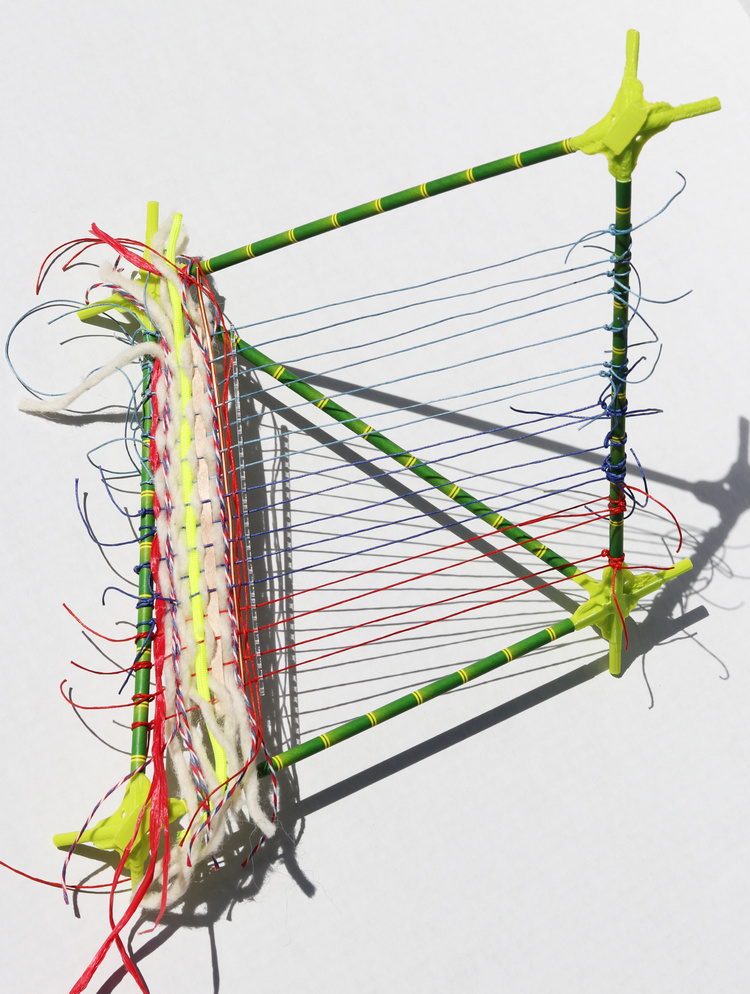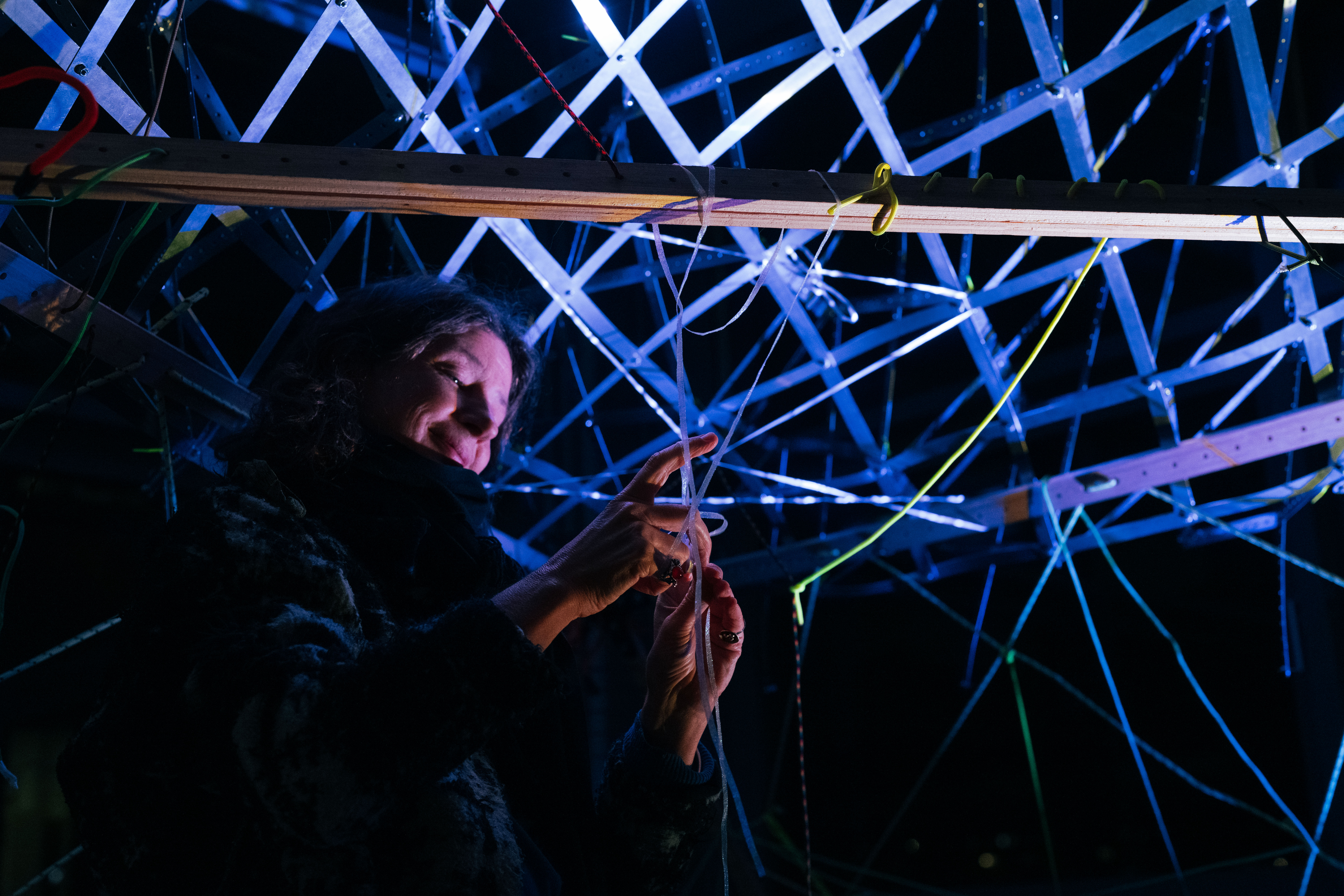Yasmine Abbas & Dk Osseo-Asare, Habit@, Mixed-media installation | Driving the Human, October 12 – October 18, 2021, Radialsystem, Berlin
 Users were invited to weave collectively through Habit@ [also imagined as a possible skin of the Fufuzela open-source architecture project] to create a three-dimensional envelope/cocoon. © Photograph: BLAKE, CAMILLE
Users were invited to weave collectively through Habit@ [also imagined as a possible skin of the Fufuzela open-source architecture project] to create a three-dimensional envelope/cocoon. © Photograph: BLAKE, CAMILLEDriving the Human is an initiative by ACATECH – National Academy of Science and Engineering, Forecast, the Karlsruhe University of Arts and Design and ZKM | Center for Art and Media Karlsruhe.
 © Photograph: BLAKE, CAMILLE
© Photograph: BLAKE, CAMILLE
 Early concept model using the frame of the Fufuzela, an open-source architecture system, as a loom. Habit@ is thought as a “skin-clothing”. The geometry later developed is inpired by the ruled surface afforded by the Fufuzela cuboctahedron geometry. © Photograph: ABBAS, YASMINE
Early concept model using the frame of the Fufuzela, an open-source architecture system, as a loom. Habit@ is thought as a “skin-clothing”. The geometry later developed is inpired by the ruled surface afforded by the Fufuzela cuboctahedron geometry. © Photograph: ABBAS, YASMINE
 © Photograph: BLAKE, CAMILLE
© Photograph: BLAKE, CAMILLE Early concept model using the frame of the Fufuzela, an open-source architecture system, as a loom. Habit@ is thought as a “skin-clothing”. The geometry later developed is inpired by the ruled surface afforded by the Fufuzela cuboctahedron geometry. © Photograph: ABBAS, YASMINE
Early concept model using the frame of the Fufuzela, an open-source architecture system, as a loom. Habit@ is thought as a “skin-clothing”. The geometry later developed is inpired by the ruled surface afforded by the Fufuzela cuboctahedron geometry. © Photograph: ABBAS, YASMINEWhat drives the Human? An enchanting place to inhabit. A habit@ in which bodies commune, “feel in close spiritual contact”[1] with other humans and species, space, the environment, and the cosmos; a living skin-clothing that connects humans with their milieu.
A “habitat” is “the place where a person or thing is usually found [1],” a material manifestation of a human’s relationship with its milieu, a space and/or territory where living beings weave habits. The Tekna nomads of Northern Africa, for example, construct a close bond with the place they inhabit by taking month – or meditative time – to weave a black tent using the hair of the animals they raise and local wood – the main tent poles are made of Argania spinosa or Argan [2]. The structure of their habitat can also serve as a loom used to weave finer cloth,[3] reminding us that the word “habit”,[1] a routine, custom or pattern, can also designate, as it is in use in current French, a garment, or by extension, a body envelop. When a building can house any people, animals, plants, insects or ghosts, a habitat is a place with which living beings are entangled, not quite yet a home, but almost.
Habit@, written with the “at” sign to highlight the contemporary context in which we live, is a multimedia installation that reflects our understanding of what architecture should be, in symbiosis with its inhabitants, living, i.e. kinetic, pliant, supple, built and woven with others using (bio)materials, experienced – inhabited – as a collective project that offers, in addition, an augmented perception of the world around.
The current version of the Fufuzela skin, hereby presented, uses thin sheets of a reflective and lightweight material – aluminum – through which material can be collectively woven to create a three dimensional envelop. The piece is foldable and vibrates as you interact with it, like a living creature.
[1] Online Dictionary
[2] Prussin, Labelle (1995), African Nomadic Architecture: Space, Place and Gender, Smithonian Institution Press and The National Museum of African Art: p. 71
[3] Clark, Gordon (2019), Tents and Other Nomadic Dwellings, Ethnographic Press: p. 29
A “habitat” is “the place where a person or thing is usually found [1],” a material manifestation of a human’s relationship with its milieu, a space and/or territory where living beings weave habits. The Tekna nomads of Northern Africa, for example, construct a close bond with the place they inhabit by taking month – or meditative time – to weave a black tent using the hair of the animals they raise and local wood – the main tent poles are made of Argania spinosa or Argan [2]. The structure of their habitat can also serve as a loom used to weave finer cloth,[3] reminding us that the word “habit”,[1] a routine, custom or pattern, can also designate, as it is in use in current French, a garment, or by extension, a body envelop. When a building can house any people, animals, plants, insects or ghosts, a habitat is a place with which living beings are entangled, not quite yet a home, but almost.
Habit@, written with the “at” sign to highlight the contemporary context in which we live, is a multimedia installation that reflects our understanding of what architecture should be, in symbiosis with its inhabitants, living, i.e. kinetic, pliant, supple, built and woven with others using (bio)materials, experienced – inhabited – as a collective project that offers, in addition, an augmented perception of the world around.
The current version of the Fufuzela skin, hereby presented, uses thin sheets of a reflective and lightweight material – aluminum – through which material can be collectively woven to create a three dimensional envelop. The piece is foldable and vibrates as you interact with it, like a living creature.
[1] Online Dictionary
[2] Prussin, Labelle (1995), African Nomadic Architecture: Space, Place and Gender, Smithonian Institution Press and The National Museum of African Art: p. 71
[3] Clark, Gordon (2019), Tents and Other Nomadic Dwellings, Ethnographic Press: p. 29

Testing – unfolding and suspending – the lightweight “loom” structure in the shop. © Photograph: ABBAS, YASMINE
TEAM HABIT@
Design Lead: Abbas, Yasmine + Osseo-Asare, Dk
Technical Drawings: Osseo-Asare, Dk + Motalebi, Mahan + Leung, Tiffany (Fufuzela team)
Fabrication: Abbas, Yasmine + Osseo-Asare, Dk + Motalebi, Mahan + Heilman, Jamie (DigiFab)
Design Participation: Fantasia, Mia + Scanlon, Luke + Sodeinde, Richard + Martin, John (Fufuzela team) + Olumide, Dara (Fufuzela team)
Technical Drawings: Osseo-Asare, Dk + Motalebi, Mahan + Leung, Tiffany (Fufuzela team)
Fabrication: Abbas, Yasmine + Osseo-Asare, Dk + Motalebi, Mahan + Heilman, Jamie (DigiFab)
Design Participation: Fantasia, Mia + Scanlon, Luke + Sodeinde, Richard + Martin, John (Fufuzela team) + Olumide, Dara (Fufuzela team)